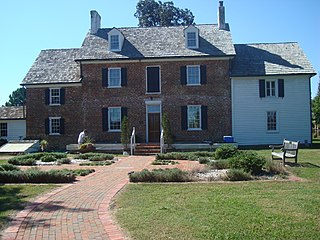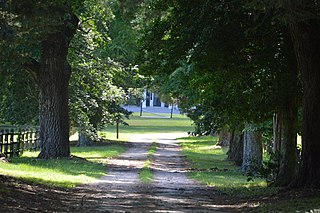
Berkeley Plantation, one of the first plantations in America, comprises about 1,000 acres (400 ha) on the banks of the James River on State Route 5 in Charles City County, Virginia. Berkeley Plantation was originally called Berkeley Hundred, named after the Berkeley Company of England. In 1726, it became the ancestral home of the Harrison family of Virginia, after Benjamin Harrison IV located there and built one of the first three-story brick mansions in Virginia. It is the home to two presidents of the United States: William Henry Harrison, and his grandson Benjamin Harrison. It is now a museum property, open to the public.

Shirley Plantation is an estate on the north bank of the James River in Charles City County, Virginia. It is located on scenic byway State Route 5, between Richmond and Williamsburg. It is the oldest active plantation in Virginia and the oldest family-owned business in North America, dating back to 1614, with operations starting in 1648. It used about 70 to 90 slaves at a time for plowing the fields, cleaning, childcare, and cooking. It was added to the National Register in 1969 and declared a National Historic Landmark in 1970.
Jacob Yoder was a pioneer of Swiss descent. He was born in Reading, Pennsylvania and died in Spencer County, Kentucky.

Berry Hill Plantation, also known simply as Berry Hill, is a historic plantation located on the west side of South Boston in Halifax County, Virginia, United States. The main house, transformed c. 1839 into one of Virginia's finest examples of Greek Revival architecture, was designated a National Historic Landmark in 1969. The surviving portion of the plantation, which was once one of the largest in the state, is now a conference and event center.

Hampton Plantation, also known as Hampton Plantation House and Hampton Plantation State Historic Site, is a historic plantation, now a state historic site, north of McClellanville, South Carolina. The plantation was established in 1735, and its main house exhibits one of the earliest known examples in the United States of a temple front in domestic architecture. It is also one of the state's finest examples of a wood frame Georgian plantation house. It was declared a National Historic Landmark in 1970.

The Reynolds Homestead, also known as Rock Spring Plantation, is a slave plantation turned historical site on Homestead Lane in Critz, Virginia. First developed in 1814 by slaveowner Abram Reynolds, it was the primary home of R. J. Reynolds (1850-1918), founder of the R. J. Reynolds Tobacco Company, and the first major marketer of the cigarette. Upon liberation of the plantation in 1863, 88 people were freed from captivity and enslavement. It was later designated a National Historic Landmark in 1977. The homestead is currently an outreach facility of Virginia Tech, serving as a regional cultural center. The house is open for tours.

Rose Hill Plantation State Historic Site is a historic site in Union County, South Carolina, that preserves the home of William H. Gist (1807-1874), the 68th governor of South Carolina. Gist helped instigate a Secession Convention in South Carolina, which led to the creation of the Ordinance of Secession that preceded the Civil War.
The Arlington Plantation House in Washington, Louisiana is an antebellum plantation house with an unusual design that was built in 1829. It was listed on the National Register of Historic Places in 1982.
Buckmeadow Plantation House was a historic plantation house located along LA 2, about 5 miles (8.0 km) northwest of Lake Providence, Louisiana. It was built in 1840 and added to the National Register of Historic Places on September 15, 1983.

The Stone Plantation, also known as the Young Plantation and the Barton Warren Stone House, is a historic Greek Revival-style plantation house and one surviving outbuilding along the Old Selma Road on the outskirts of Montgomery, Alabama. It had been the site of a plantation complex, and prior to the American Civil War it was known for cotton production worked by enslaved people.

Montpier, also known as Nicholas Perkins House, is a two-and-a-half-story brick house built on a stone foundation during 1821–22. It has a gable roof with twin brick chimneys at each gable end. It was built with slave labor. Its original style was Federal, but its facade was modified in the 1859s by addition of a Greek Revival two-tiered portico and a doorway with side lights, corner lights and transom.

Ferry Plantation House, or Old Donation Farm, Ferry Farm, Walke Manor House, is a brick house in the neighborhood of Old Donation Farm in Virginia Beach, Virginia. The site dates back to 1642 when Savill Gaskin started the second ferry service in Hampton Roads to carry passengers on the Lynnhaven River to the nearby county courthouse and to visit plantations along the waterway. A cannon was used to signal the ferry, which had 11 total stops along the river. The first ferry service was started nearby by Adam Thoroughgood.

The Houmas, also known as Burnside Plantation and currently known as Houmas House Plantation and Gardens, is a historic plantation complex and house museum in Burnside, Louisiana. The plantation was established in the late 1700s, with the current main house completed in 1840. It was named after the native Houma people, who originally occupied this area of Louisiana.

Brick House, also known as Woodlands, is a historic plantation house located at White Plains, Brunswick County, Virginia. It was built about 1831–1833, and began as a two-story, brick I-house. It was remodeled in 1860, with the addition of the massive hexastyle portico covering the entire front facade. Also on the property is a contributing 19th-century outbuilding connected to the main house by a covered walkway.
The Laurel Hill Plantation in Adams County, Mississippi, about 12 miles (19 km) south of Natchez, Mississippi, is a historic Southern plantation. It was nominated for listing on the National Register of Historic Places, and was listed in 1982. The main house of the plantation no longer exists. The listing includes a historic brick church named St. Mary's Chapel and a building from 1835 to 1840 which was a parsonage for the church, or was an outbuilding to the parsonage, and other outbuildings.

The Birthplace of Patrick Henry (1736–1799), the Founding Father and American statesman from Virginia, was a farmhouse called "Studley", located in what is now the village of Studley in Hanover County, Virginia. The house, a two-story brick structure, was built in the 1720s by John Symes, whose wife Sarah married Patrick Henry's father John after Symes died. Patrick Henry was born in the house on May 29, 1736. By 1796 the farmstead included a significant number of outbuildings. The house was destroyed by fire in 1807, and now only archaeological remnants remain.

Seaside Plantation House, also known as Locksley Hall, is a historic plantation house located at Edisto Island, Colleton County, South Carolina. It was built about 1810, and is a 2+1⁄2-story, Federal style brick dwelling with a gable roof. The house is one room deep with a long porch across the southeast elevation and sits on a raised basement. The central portion of the house is stuccoed brick with frame additions on the first floor.
The George Matthias Bernhardt House is a historic plantation house located near Rockwell, Rowan County, North Carolina.
Beechland, in Jeffersontown, Kentucky, was built in 1812. It was listed on the National Register of Historic Places in 1983. The listing included three contributing buildings.

Beechland, near Taylorsville, Kentucky, was built in 1804. It was built by Jacob Yoder and has also been known as Jacob Yoder House. The listing included four contributing buildings.















